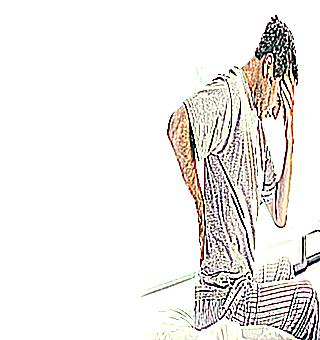Home >
Erectile Dysfunction >
Painful ejaculation
Painful ejaculation

The male body is susceptible to various diseases of the genitourinary system. The most common pathologies are urethritis, sexually transmitted diseases, vesiculitis, prostatitis. Diseases of the genital area always have certain symptoms. One of the common symptoms that worries men is pain during ejaculation.
With this pathological phenomenon in men, the psychological state and health, in general, are disturbed.
What factors trigger a painful symptom
A painful sensation can manifest itself in men of different age groups.
What reasons can provoke an unpleasant phenomenon?
- Men who frequently use interruption of intercourse have similar symptoms.
- Pain during ejaculation occurs in a strong half of humanity who engage in regular masturbation.
- Soreness at the end of sexual intercourse occurs due to pathological processes in the genitourinary system.
Among genitourinary diseases that can provoke pain during and after sex are vesiculitis, prostatitis, phimosis. In men, these diseases occur due to unprotected sexual intercourse.
Painful sex with vesiculitis
Vesiculitis is the inflammation of the semen vesicles. The seminal vesicles are located above the prostate gland, near the vas deferens. The formations under consideration provide the cells of the genital area with energy, and also have a protective function. The seminal vesicles are involved in the utilization of semen, which remains in the cavity tissue.
Vesiculitis can develop in an infectious and non-infectious way:
- Infectious causes include bacterial foci, viruses, chlamydial infection. Specific foci include tubercle bacillus, gonococci, Trichomonas. The disease of vesiculitis in men can provoke other pathologies, such as inflammation in the prostate gland, epididymitis, urethritis.
- Non-infectious causes include congestion in the prostate gland. Stagnant phenomena include impaired venous outflow, sperm congestion. Congestion occurs due to frequently interrupted sexual intercourse, addiction to alcohol, masturbation, irregular sexual activity, physical inactivity, hemorrhoids, hypothermia.
The most common symptom of vesiculitis is the release of semen. Additional symptoms included pain in the prostate, groin, weakness, and fever. In addition to the painful sensation, the quality of the semen can be reduced. Men may produce less semen.
Painful ejaculation in chlamydia
As mentioned, the causes of painful ejaculation are infections transmitted through sexual intercourse. Chlamydial infection plays a special role in the onset of the pathological process. Chlamydia is provoked by intracellular microorganisms that affect the genitourinary system. Among infectious diseases, chlamydia is the most common sexually transmitted infection.
The disease in question is marked by inflammation of the urethral canal. There is a glassy discharge, a scanty amount. Patients have a fever, a weakening of the body is felt, eggs, groin, perineum hurt. With chlamydia, painful ejaculation is not common, but it does happen. Sometimes there are traces of blood in the semen.
Some men do not pay attention to chlamydial infection, so sometimes, any symptoms are absent. To diagnose the disease, laboratory testing, bacterial culture, PCR, ELISA are carried out. A scraping is taken from the patient. Chlamydia has serious complications.
Interruption of intercourse
Painful symptoms during ejaculation can happen from improper sexual acts. Young people often practice interruption of sexual intercourse. Systematic suppression of ejaculation causes painful ejaculation. Interruption of sexual intercourse is one method of contraception, but it is not safe for male health. With regular retention of ejaculation during intercourse, pain is felt when ejaculating.
Delays play a huge role - a man receives psychological stress. To normalize ejaculation, you should abandon delays during sexual intercourse. The contraceptive method needs to be replaced with a safer one.
Sometimes the prostate of men hurts after ejaculation from irregular intercourse. In some cases, male fear, anxiety before ejaculation can be reflected by painful ejaculation.
Mechanical injury was noted among other causes of pain syndrome.Injuries can happen in an absurd way, for example, after using a condom of the wrong size.
Inflammatory processes of the prostate
The prostate gland sometimes becomes inflamed in men. Pathology occurs after the penetration of bacteria. Sometimes because of the banal Escherichia coli, Staphylococcus aureus, Pseudomonas aeruginosa, Proteus, an inflammatory process in the prostate gland can erupt. At the same time, men have pain during urination, fever, soreness of the lower peritoneum, cramps with burning in the urethral canal, myalgia.
Very often, men feel soreness during ejaculation, patients have pain in the testicles, perineum, groin. There are several reasons for the occurrence of the inflammatory process of the prostate.
Chronic infection:
- Pneumonia;
- Flu;
- Purulent diseases;
- Prostate congestion;
- Hypothermia;
- Stressful situations;
- Hypodynamics;
- STI.
Prostatitis is diagnosed based on the results of anamnesis, patient complaints, laboratory tests, instrumental research. For this, a smear is taken from the urethral canal, microscopic examination, ultrasound examination, CT, MRI are performed. An in-depth study is carried out to identify other pathologies in the pelvic organs.
Methods of getting rid of painful symptoms
Painful symptoms of ejaculation with venereal causes are treated with antibiotic therapy. Treatment is based on the type of infection.
Pain during ejaculation caused by prostatitis is treated with pain relievers. Antispasmodics are used to restore normal urine output.
Patients should drink plenty of fluids.
Severe prostate inflammation is treated with hydration.
A specialist may prescribe diuretics.
With vesiculitis, it is recommended to relieve the painful syndrome, with the destruction of microorganisms. For this, antibiotic therapy is used. Medicines in this group should be of a wide spectrum of action. These can be macrolide drugs, penicillin group, fluoroquinols. In case of stagnation, the use of angioprotectors, massage, physiotherapy is prescribed.



























